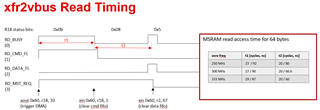Part Number: SK-AM64
Hello,
i saw this forum post:
that pointed to another forum post.
It seems like the original poster didn´t need the answer - but for me, especially question 5 is still relevant:
Quote:
"Question 5:
In several examples, I have seen the following macros for the Write implementation
m_xfr2vbus_write32 .macro xid, addr_low, addr_high
ldi32 r10, addr_low
ldi r11.w0, addr_high
xout xid, &r2, 40
.endm
m_xfr2vbus_write64 .macro xid, addr_low, addr_high
ldi32 r18, addr_low
ldi r19.w0, addr_high
xout xid, &r2, 72
.endm
These macros work perfectly. But if I change the following lines in macros:
m_xfr2vbus_write32: xout xid, &r2, 40 -> xout xid, &r2, 32
m_xfr2vbus_write64: xout xid, &r2, 72 -> xout xid, &r2, 64
they do not work.
Why do I have to specify a length of 40 for 32 bytes to be written and a length of 70 for 64 bytes to be written?
How will the xout command look like to write 1/4/8 bytes of data (What should be the argument length for xout command to write 1/4/8 bytes)? "
If there is allready further documentation on how to use the XFR2VBUS Hardware Accelerator correctly, i would be happy about a hint. Another question on this topic is:
Is it necessary to use assembly language to use the accelerator effectively?
(Until now i was abled to achieve good results with C-code in PRU projects under CCS 11.1.0 with the PRU C-Compiler v2.3.3)
regards,
Dominik



